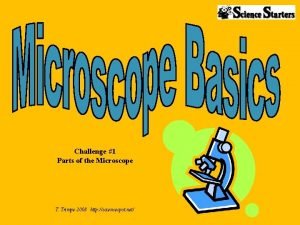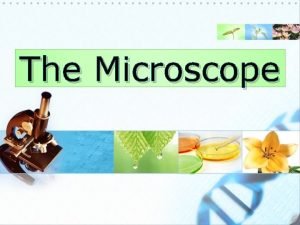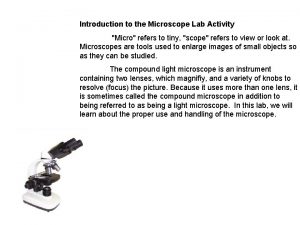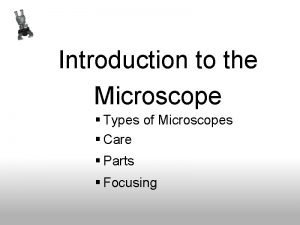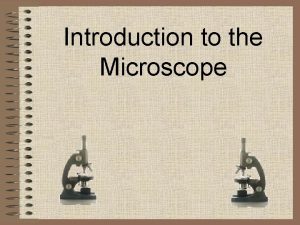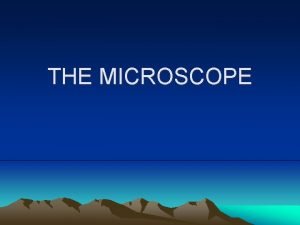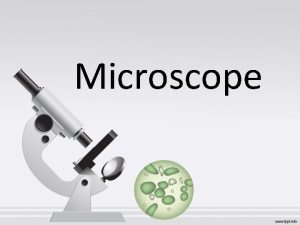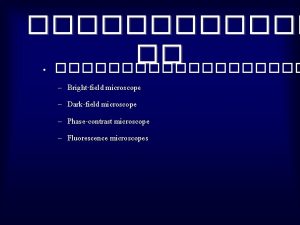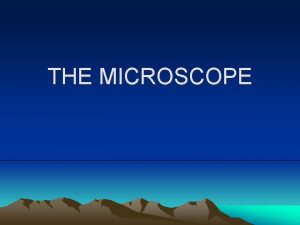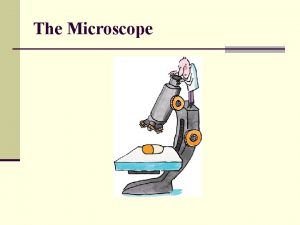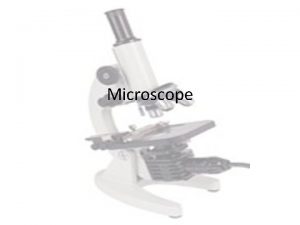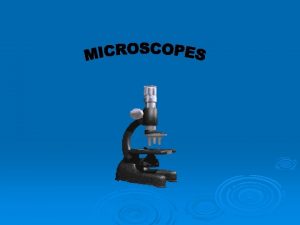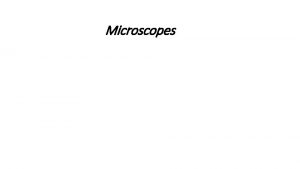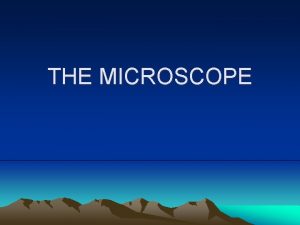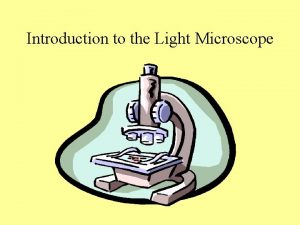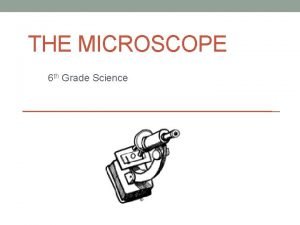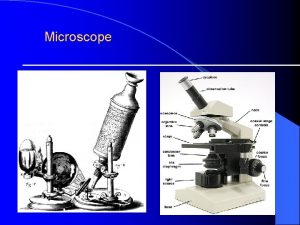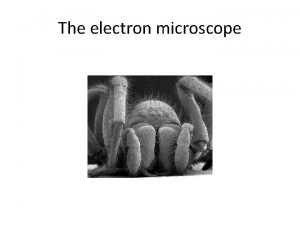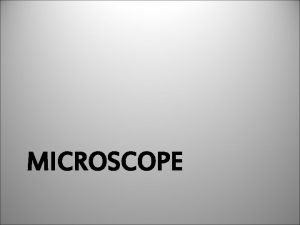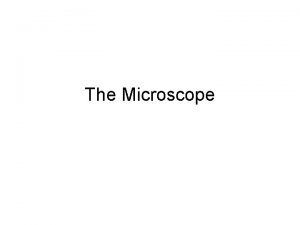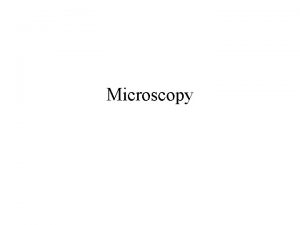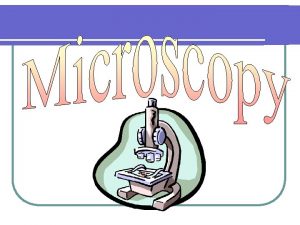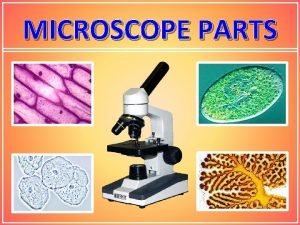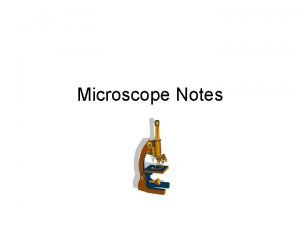The Microscope The Microscope An Introduction The microscope



























- Slides: 27

The Microscope

The Microscope – An Introduction The microscope is among the most widely used tools in biology. A microscope is an instrument that: produces an enlarged image of an object. Biologists use microscopes to study cells, cell parts, and too small to be seen with the naked eye. organisms that are ____ Microscopes both _______ enlarge the image of an object and show its details ________.

There are two types of microscopes: Light Microscopes: Electron Microscopes: Forms an image of a specimen using a beam of electrons rather than light. Light passes through one or more lenses to produce an enlarged image of a specimen.

The History of the Microscope and Early Cell Studies Zaccharias Janssen and his son Hans - 1590 Two Dutch spectacle makers, Zaccharias Janssen and his son Hans, while experimenting with lenses in a tube several _______, discovered that: nearby objects appeared greatly enlarged.

Zaccharias Janssen and his son Hans - 1590 This was the first very basic compound microscope. A compound microscope is one that has: two sets of lenses.

The Compound (Light) Microscope Some early microscopes… Compound Microscope: This microscope allows light to pass through the specimen and uses two lenses to form an image.

Robert Hooke – 1665 Robert Hooke used a crude microscope to observe a: thin slice of cork. The chambers he saw reminded small rooms in which him of the ______ monks lived, so he called them cells “_____”. He was the first to use the word “cell” to smallest units of life. describe the _________.

Drawings made by Robert Hooke. Although Hooke’s microscope had three lenses, they were of very _____ poor quality and he could see very _____. little detail

Anton van Leeuwenhoek – 1674 Leeuwenhoek was a Dutch merchant who experimented with the: grinding of lenses. He was able to polish lenses of great curvature that obtained a magnification of nearly _____. 300 times simple He built a ______ microscope. A simple microscope is: a microscope that has only one lens.

Anton van Leeuwenhoek – 1674 He is considered The Father of Microscopy “___________” because of the great discoveries he made with his microscopes. He built over ___ different microscopes. 240 Drawings made by Leeuwenhoek

Anton van Leeuwenhoek – 1674 He was the first to… …see and describe microorganisms under a microscope. He observed a drop of pond water teeming with life. He referred to tiny animalcules these small microorganisms as “_______”. He also described bacteria, yeasts, and the circulation of blood through capillaries in the tail of a fish.

1. Ocular: The first lens in a compound microscope. The Microscope 2. Objective Lens: The second set of lenses in a compound microscope. 3. Body tube: Keeps the two sets of lenses the correct distance apart. 4. Rotating Nosepiece: Allows the user to change objectives. 5. Stage: A place to put the slide. 6. Stage Clips: Holds the slide in place.

7. Diaphragm: Regulates the amount of light that hits the slide. 8. Light source 9. Coarse Adjustment Knob: Moves the stage up and down rapidly. 10. Fine Adjustment Knob: Moves the stage up and down very slowly. 11. Arm 12. Base The Microscope

The Compound (Light) Microscope This microscope allows light to pass through the specimen and ____________ two lenses to form an uses _____ image. The modern compound microscope is capable of two things: a) Magnification b) Resolution

Magnification is a measure of how much the image is enlarged. Total magnification = (ocular) (objective) 4 x objective = (10) ( 4) = 40 times magnification 10 x objective = (10) = 100 times magnification 40 x objective = (10) (40) = 400 times magnification NOTE: Many oculars have a magnification of 10 x, but it is possible for a microscope to have an ocular that magnifies differently.

Resolution: a) A measure of the clarity of an image. b) It is the power to show details clearly. Microscopes vary in powers of magnification and resolution.

Rules for Using the Compound Microscope 1. Always carry the microscope by: the arm with the other hand supporting the base. 2. Turn on the microscope and place your slide on the stage. Please follow these rules when using the microscope: 3. Always start with the _____. 4 x objective Focus this objective coarse adjustment knob using the __________. 4. Once the image is in focus, carefully swing the ______ 10 x objective in place. coarse adjustment knob Focus this objective using the __________.

Rules for Using the Compound Microscope 5. Once the image is in focus, very objective carefully swing the 40 x ______ into place. Focus this objective using ONLY the _________. fine adjustment knob Please follow these rules when using the microscope: 6. Never use the coarse adjustment knob while using the high power objective. 7. Keep the stage ____ dry and always make sure the bottom of slide is dry before putting it on the microscope. your ____ 8. Return your objective to _______ low (4 x) power before you put the microscope away.

Preparation of a Wet Mount Slide Most of the slides we will make are wet ____ mount slides. Wet mount slides are used living organisms to view _______, liquid as well as _____ substances of all kinds. They are also used for any sort of specimen that moist needs to be kept _____.

Preparation of a Wet Mount Slide 1. Obtain a _______. clean, dry slide 2. Put your _____ specimen in the center of the slide. 4. Hold a clean coverslip at a _______ 45 -degree angle ____ over the specimen. Allow one edge of the coverslip to touch the edge of the drop of water. 3. Add one large drop of ______. water (It should be one solid drop of water over the specimen. ) It should not… …. run all over the slide or get on the back of the slide. 5. Gently drop the coverslip into place. 6. The whole coverslip should be in contact with water, but make sure the back of the slide is dry.

How to Measure Under the Microscope The unit of measurement used to measure things under the microscope micrometer ( m) is the ________. . 000001 meter or 1/25, 000 inch One micrometer = _______________. Using the 10 x objective… The 10 x objective has a field of view with a diameter of 1500 m. Estimate the size of the cell in the drawing to the left. With the 10 x objective, the size of the cell would be about 400 μm.

How to Measure Under the Microscope Using the 40 x objective…. The 40 x objective has a field of view with a diameter of 375 m. Estimate the size of the cell in the drawing to the left. With the 40 x objective, the size of the cell would be about 100 μm.

The Electron Microscope _____ Resolution is the limiting factor to a light microscope. At greater resolve the image magnifications, the light microscope is unable to ________. At powers of magnification beyond 2000 x _____, the image becomes ______. blurry To examine cells or cell parts at magnifications greater than 2000 x, scientists use electron microscopes.

Characteristics of the Electron Microscope 1. Does not use light. 2. A beam of electrons produces an enlarged image of the specimen. 3. Both the electron beam and the specimen must be placed inside a ________ vacuum chamber so that the electrons in the beam will not bounce off _______ gas molecules in the living things cannot survive in a vacuum, air. Since ______ electron microscope cannot be used to view the _________ living cells. 4. Electron microscopes are much more powerful than light microscopes. pollen Dust mite mitochondrion

Electron Microscopes There are two types of electron microscopes: 1. Transmission Electron Microscope 1. Scanning Electron Microscope

Transmission Electron Microscope (TEM) It uses a ________ stream of electrons transmitted through a very thinly sliced _____. specimen Magnets _______ guide the stream of electrons toward the specimen, and the image is projected on a ________. photographic plate Disadvantage: Advantage: Magnification up to 200, 000 times. The method used to prepare the specimen will kill the cells so that living cells cannot be observed.

Provides excellent threedimensional images. Scanning Electron Microscope (SEM) The specimen is not sliced _____ for viewing, but the specimen is sprayed with a fine metal coating. _______ Like the transmission electron microscope…. . ……living cells cannot be viewed. When the beam of electrons is passed over the specimen’s surface, it causes the metal coating to emit a shower of electrons. A three-dimensional __________ image of surface of the specimen is projected the _______ on a photographic plate. The scanning electron microscope can magnify 100, 000 times.
 Light microscope vs electron microscope
Light microscope vs electron microscope Microscope mania compound light microscope
Microscope mania compound light microscope Introduction on microscope
Introduction on microscope Introduction to the microscope lab
Introduction to the microscope lab Microscope introduction
Microscope introduction Hát kết hợp bộ gõ cơ thể
Hát kết hợp bộ gõ cơ thể Lp html
Lp html Bổ thể
Bổ thể Tỉ lệ cơ thể trẻ em
Tỉ lệ cơ thể trẻ em Voi kéo gỗ như thế nào
Voi kéo gỗ như thế nào Thang điểm glasgow
Thang điểm glasgow Alleluia hat len nguoi oi
Alleluia hat len nguoi oi Môn thể thao bắt đầu bằng chữ đua
Môn thể thao bắt đầu bằng chữ đua Thế nào là hệ số cao nhất
Thế nào là hệ số cao nhất Các châu lục và đại dương trên thế giới
Các châu lục và đại dương trên thế giới Công của trọng lực
Công của trọng lực Trời xanh đây là của chúng ta thể thơ
Trời xanh đây là của chúng ta thể thơ Cách giải mật thư tọa độ
Cách giải mật thư tọa độ 101012 bằng
101012 bằng độ dài liên kết
độ dài liên kết Các châu lục và đại dương trên thế giới
Các châu lục và đại dương trên thế giới Thể thơ truyền thống
Thể thơ truyền thống Quá trình desamine hóa có thể tạo ra
Quá trình desamine hóa có thể tạo ra Một số thể thơ truyền thống
Một số thể thơ truyền thống Cái miệng xinh xinh thế chỉ nói điều hay thôi
Cái miệng xinh xinh thế chỉ nói điều hay thôi Vẽ hình chiếu vuông góc của vật thể sau
Vẽ hình chiếu vuông góc của vật thể sau Thế nào là sự mỏi cơ
Thế nào là sự mỏi cơ đặc điểm cơ thể của người tối cổ
đặc điểm cơ thể của người tối cổ

